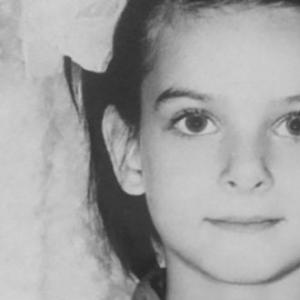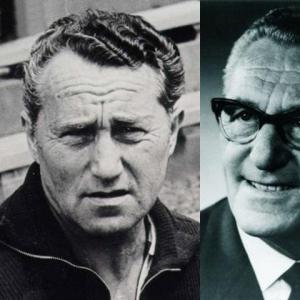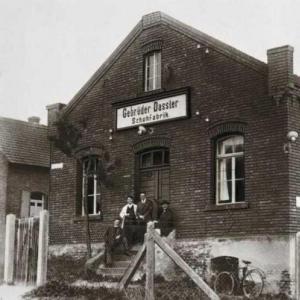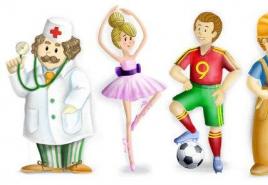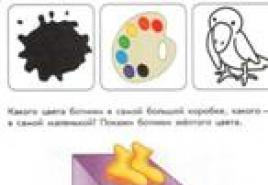The path to success: the history of the adidas brand. Adolf Dassler pioneer of the era of commercialization of sports Dassler shoes
The Adidas brand is probably known to everyone in our country. The popularity of shoes and clothing supplied by this German company, including to the domestic market, is truly enormous. The founder of the world famous company Adidas is a German entrepreneur of Jewish origin A. Dassler.
Childhood
small townHerzogenaurach -place where he was born on November 3, 1900Adolf Dassler. Familyhis was not rich.Adi's mother worked as a laundress, and her father worked as a baker. Adolf grew up as a quiet, intelligent boy. The only thing he was truly passionate about was football.
In 1914, Germany began the First World War, which ended in 1918 with its defeat. Devastation and hunger reigned in the country. Thousands of soldiers returning from the front swelled the army of unemployed people. Adolf's parents also lost their income. They were practically unable to feed themselves and their children. Adi, who by that time was 18 years old, and his brother Rudolf were still trying to find work for some time. However, absolutely nothing came of this venture. And then, in order to somehow make ends meet, at the family council the Dasslers decided to open their own small shoe workshop.
First products
The Dasslers, of course, did not have free space to place the equipment. And then the family decided to use the mother’s laundry as a new workshop. Anyway, she had few orders at that time.
Actually, the Dasslers also had practically nothing to buy the equipment for sewing shoes. But somehow the family still found a way out of the situation. Adi’s ingenuity also helped with this. From his old bicycle, the young man assembled a convenient machine for cutting skins. In the future, Adolf Dassler also very often showed the ingenuity that contributed to the success of the family business. The first shoes of the new workshop, although simple in design, were quite popular in the chilly climate of Germany. The Dassler family decided to start their business with sleeping slippers. They were sewn by newly minted shoemakers from used military uniforms. Old car tires were used for the soles.
At first, of course, the Dasslers had no hired workers. The base for the slippers was cut and carved by Adolf's mother and sisters. Adi himself, his brother and father were engaged in the actual tailoring. Rudolf was responsible for product sales. Adi was assigned the role of production coordinator and designer.
"Dassler Brothers Shoe Factory"
The products produced by the workshop were thus quite in demand. And therefore, the new Dassler family enterprise quickly became profitable. Just four years after the opening of the shoe shop, in addition to themselves, 12 more hired workers worked. The expanded mini-factory produced up to 50 pairs of shoes per day.

In June 1924, the family decided to officially register their successful enterprise and give it the name “Dassler Brothers Shoe Factory.” Subsequently, Adi and Rudi's business continued to develop rapidly. Adolfwas still responsible for the design of the shoes produced by the company, and Rudolf was responsible for its sales.
In 1925, the factory was doing so well thatAdolfDassler, biographywhich was now most closely associated with shoe production,decided to take some liberties and developed boots with spikes that were comfortable for playing his favorite football. Soon the new model was put into production. This is how the first studded sports shoes appeared in the world. At the same time as boots, the factory began producing gymnastic slippers.
Renting and purchasing a plant
By 1927, the Dassler shoe production had grown so large that it no longer even fit into the courtyard of the house. And then the family decided to rent a large building for their factory. At the same time, the company's staff was increased to 25 people. Now the company was producing about 100 pairs of shoes per day. After some time, the rented building was bought by the Dasslers. The family itself moved from their old small house to a nearby mansion.
Shoes for the Olympics
The success of the Dassler enterprise was based primarily, of course, on the quality of the products and their convenience. Studded boots and gymnastic slippers produced by this small company were sold out in stores instantly. And after some time, Adolf came up with the idea of sewing sports shoes forthe strongestOlympic participants.This decision, in fact, became the starting point for the world fame of the new brand.
For the first time, German athletes wore Dassler brand shoes at the 1928 Olympics in Amsterdam. Back then, no one paid much attention to the new sports accessory. However, already at the next Olympics, held in 1932 in Los Angeles, the German A. Yonath, who competed in Dassler shoes, took third place in the 100 m race. It was then that this new brand, in fact, became known to the public .

The real excitement around the Dassler brand, however, began only in 1936. At the Olympics in Berlin, the American runner D. Owen won four gold medals wearing these boots, setting 5 world records. Thanks to this athlete, the Dassler brand has become a recognized standard in sports shoes. Factory sales that year exceeded 400 thousand German marks.
The Dasslers decided to reinvest the profits they made during and after the Olympics into expanding their business. In 1938 the family boughtHerzogenaurach another factory.
Nazi Germany
By the time Hitler came to power, the production volumes of both family factories reached 1000 pairs of shoes per day. Both brothers -Adolf and RudolfDasslers -by that time they had already become active members of the Nazi Party.The brothers fully supported the new government. However, this did not save them from trouble. Perhaps it was their Jewish origin that was to blame, but in 1939, with the outbreak of World War II, their factories were confiscated. The authorities sent the brothers Adolf and Rudolf to the front.
Later, at one of the factories owned by the family, the Nazis tried to establish the production of grenade launchers. However, since the plant's equipment was absolutely not adapted for this purpose, this idea completely failed. And then the new town authorities decided to return Adolf from the front. He was tasked with producing training shoes for German soldiers.
Enterprise after the war
Germany, as we know, lost World War II in disgrace. In 1945, the Dassler factories found themselves in the American occupation zone.The new government did not recognize the authority of even such a well-known entrepreneur before the war asAdolf Dassler. Brothera businessman was sent to a camp for participating in hostilities.BelongingorThe Allies adapted the Dassler factory to produce hockey skates for supply to the USA.American officers settled in the family mansion of entrepreneurs.

MyselfAdolf Dasslerwith my wife at the timedug upgarden beds andlooked afterand livestock in order to somehow make ends meet. However, this situation did not last long. A year later, the Americans left, and Rudolf returned from the camp. The Dasslers again became full owners of their factories.
Split
Raised a family businessafter the warAdolf and Rudolf Dasslerpractically from scratch. Their brand was produced againfrom the remains of military uniforms. Only 47 people worked as shoemakers in the factories. Moreover, they received their salaries not in money, but in firewood and yarn.
Be that as it may, the factory's affairs gradually improved. But, unfortunately, there was no longer the former mutual understanding between the brothers themselves. Rudolph never forgave Adolf for the fact that he, using his acquaintance with American officers, did not rescue him from the camp.
The final breakdown between Adi and Rudi occurred in 1948. The brothers decided to split the company.AdolfDasslertook one factory for himself, and Rudolf took another. By agreement between them, neither of them could use the family brand. Thus, the famous shoe brand Dassler ceased to exist. Adi named his new company Addas, and Rudi named it Ruda. The first was later renamed Adidass (from Adi Dassler), and the second was renamed Puma.

Once they quarreled, the Dassler brothers never made peace. Even today, the two most famous brands - Adidas and Puma - remain merciless competitors in the market.
Breach of contract
After breaking up with my brother,AdolfDasslerbecame the sole owner of his enterprise. He no longer communicated with Rudolf. Some time after the quarrel, Adi even slightly violated the agreement concluded with his brother on the non-use of Dassler symbols. For his new products, he took two famous stripes from the old brand and simply added a third to them. This became the symbol of the new Adidas shoes.
Be that as it may, in order to beat his brother in the competition, Adolf had to use all his ingenuity in subsequent years:
In 1949Adolf Dassler's first pair of shoes is releasedWitho removable spikes.
In 1950, Adi develops boots designed for playing football in bad weather.
Adolf's shoes, innovative for that time, turned out to be very comfortable and immediately became extremely popular. At the 1952 Olympics in Helsinki, the best athletes no longer competed in Dassler shoes, but in Adidas boots.
Adidas suits
At the same 1952 Olympics, Adolf, among other things, came up with the idea of producing not only shoes for runners and football players, but also other sports goods. After some time, he started producing sports bags. A few months later, to the weaving factory of a large entrepreneurSeltenreich received an order from Adolf to sew 1000 Adidas tracksuits.
Advertising in stadiums
In 1954, the German football team, wearing Adidas boots, won the world champion title. Adolf's shoes become even more popular. At the same time, Adi comes up with the idea of advertising his brand directly in stadiums. And already in 1956 he signed a corresponding agreement with the Olympic Committee. Thus, with the light hand of Dassler in the middle of the last century, the modern era of commercialization of sports opened.

Decline
DiedAdolf Dassler in old age -in 1978. Unfortunately, his children were not able to develop the enterprise with the same success. Just like Adi and his brother once did, the young businessmen quarreled among themselves, trying to challenge each other for control of the factory. This quarrel ended disastrously for the enterprise, of course. The factory, to which Adolf Dassler devoted his entire life, was sold in the 80s for almost nothing - for $390 million. Today she isa typical joint-stock company for our time, which does not have large co-owners.
Currently, about 14 thousand craftsmen work at the Adidas factory. Its sales amount to 6.3 billion euros annually, and its net profit is 260 million. In addition to Adidas itself, the concern also includes such well-known brands asArc"Teryx, Salomon, Maxfl and some others.

Livel Adolf Dassler(photo ethat person can be seen on the page above), sothus, a very long and rich life. His age at the time of death was as much as 78 years. The factory, which he created at the beginning of the century, in 1978 was already producing about 45 million pairs of sports shoes annually. Today, many different interesting facts are known about the Adidas company and its founder. So, for example:
At the 1960 Olympics in Rome, 75% of athletes competed in Adidas shoes.
In 1977, English footballer S. Bowles took to the field wearing different boots. He had an Adidas sneaker on one foot andGola.For such an unusual advertisement, the athlete received4 00 thousand pounds sterling fromAdolf Dassler and 200 - from Gola.
In 2004, Adidas began collaborating with famous fashion designer Stella McCartney. Currently, the factory, among other things, actively produces a line of women's sportswear.
In 2006, the famous brand was added to the plantReebok. Its shareholders bought it for $3.8 trillion.
INIn 2016, a documentary film was made about the founding of the factory. The television crews, of course, became interested in the fate of such a famous person asAdolf Dassler. Movie"Duel of Brothers. The Story of Adidas and Puma"narratesabout the events that unfolded at the family enterprise of Adi and Rudi after the war.
The logo of the Adidas company has changed several times throughout its existence. However, the famous three stripes have been preserved to this day. The modern logo of the plant unites them in a triangle, which symbolizes the mountain as a metaphor for the goal facing any athlete.
Adolf Dassler was born on November 3, 1900 in the small Bavarian town of Herzogenaurach. His mother was a laundress and his father was a baker. Adi, as Adolf was called in the family circle, grew up as a quiet boy. When he was 14 years old, Germany began the First World War, but Adi did not go to the front due to his youth. He didn't want to go there. His passion was football, which just then became the most popular game in Europe.
In 1918, the war ended with the defeat of Germany. Devastation and inflation reigned in the country, and millions of soldiers returning from the front joined the army of unemployed. Bad times have come for the Dassler family. Having worked at odd jobs, at the beginning of 1920 the Dasslers at a family council decided to organize a family business - sewing shoes.
The Dasslers approached the implementation of the idea with German thoroughness. The mother's laundry room was given over to the shoe workshop. The inventive Adi converted a bicycle into a machine for cutting skins. His sisters and mother made patterns from canvas. Adi, his older brother Rudolf (or Rudi in the family) and his father cut shoes.
The Dassler family's first product was sleeping slippers. The material for them was decommissioned military uniforms, and the soles were cut from old car tires. Rudy took over the marketing of these conversion products. Adi was involved in organizing production and inventing new models. After four years, twelve workers, including family members, were producing 50 pairs of shoes a day. And in July 1924, the Dassler Brothers Shoe Factory company was founded.
Both brothers with their opposite personalities complement each other well. If Adi was an inventive and timid intellectual and played football, then Rudi had an explosive character and loved sex, jazz and boxing.
By 1925, the company was doing so well that Adi could afford a little imagination. As an avid soccer player, he designed and made spiked soccer boots that were forged for him by a local blacksmith. Thus, studded sports shoes were born.
The football model turned out to be comfortable and, together with gymnastic slippers, became the main product of the Dasslers. Soon the production no longer fit in the courtyard of their house. In 1927, the Dasslers rented an entire building for their factory. Now the staff has been increased to 25 people, and production to 100 pairs of shoes per day. Soon the Dasslers bought the rented factory, and the whole family moved to a mansion located not far from it.
Olympic "Dassler"
Best of the day
Adi no longer remembered that several years ago he was going to become a baker. Now he was completely captivated by the opportunity to make sports shoes and then test them in sports games with his friends. The success of studded football boots inspired Adi to make shoes specifically for the strongest participants in the Olympics. For the first time, athletes performed in Dassler studded shoes at the 1928 Olympics in Amsterdam. At the next Olympics in 1932 in Los Angeles, the German Arthur Yonath became third in the 100 meters. But the most successful year for Adi was 1936. His first child was born, and at the Berlin Olympics, the black American runner Jesse Owens, wearing Dassler shoes, won four gold medals and set five Olympic records.
From that moment on, Dassler became an unrecognized standard in sports shoes. The success of Adi's marketing was obvious. In the year of the Berlin Olympics, sales of the Dassler Brothers Factory exceeded DM 400,000. In 1938, the second Dassler factory opened in Herzogenaurach. In total, their company produces 1,000 pairs of shoes every day.
Convinced Nazis
By this point, both Dassler brothers were committed members of the Nazi Party. And when Germany started a new world war in 1939, they repurposed production to produce military shoes. Here the Dassler brothers' common understanding of their duty to their homeland ended. Rudi went to fight, and Adi remained to manage the family business.
When Germany lost that war, Adi suffered her share of national disaster. In 1945, Herzogenaurakh fell into the American occupation zone. And while the Dassler factory supplied hockey skates to the United States on indemnity, the Yankees settled comfortably in the family mansion. And Adi’s wife, in order to feed the family, dug up the beds and looked after the livestock herself. But it didn't last long. A year later, the Americans left, and Rudy's brother returned from the prisoner of war camp.
The brothers had to start their family business almost from scratch. Dassler shoes were again made from the remains of military ammunition, and 47 hired workers received wages in kind - firewood and yarn. True, the former understanding between the brothers was no longer there. And in the spring of 1948, shortly after the death of their father, they finally quarreled and decided to split the company. Rudi took over one factory, and Adi took over another. The brothers also agreed not to use the name and symbols of the family enterprise. Adi named his company Addas, and Rudi - Ruda. But after a few months, Addas became Adidas (an acronym for Adi Dassler) and Ruda became the name of the forest tiger Puma. This is how the world famous Dassler brand died.
The brothers themselves remained silent until the end of their days about the reasons for the quarrel. Perhaps Rudi was never able to forgive Adi for not trying to rescue him from the prisoner of war camp after the war, using his acquaintance with American officers. Or maybe they simply could not share their father's inheritance. In any case, after the collapse of the family business, the brothers did not speak to each other, and Puma and Adidas became their fiercest competitors.
Moreover, the feud between the founders of Puma and Adidas spread to their hometown of Herzogenaurach. Each company maintained its own football team in the city, their employees ostentatiously drank different beers, and even the employees' children attended different schools.
Suits with stripes
After parting with his brother, Adi became the sole owner of his own company. Now he did not need to consult anyone. Taking advantage of this “permissiveness”, a year later he “slightly” violated the agreement with his brother - not to use the symbols of the “Dassler Factory”. Adi took two stripes in the Dassler logo, added a third to them and patented this as the Adidas symbol.
In order not to allow his brother to bypass him, Adi takes up his favorite activity - invention. In 1949, he creates the first boots with removable rubber studs. In 1950 - football boots, adapted for playing football in adverse weather conditions: on snow and frozen ground. At the same time, he recalls all the old connections with the national Olympic committees. At the 1952 Helsinki Olympics, most athletes no longer wore Dassler, but Adidas.
At the same Olympics, Adi came up with the idea of offering athletes other products under the Adidas brand. The first attempt at diversification was the production of sports bags, which began a few months later. And although sneakers remain the main production, Adi is looking for a partner who will take over the production of clothing. By chance, at some party, Adi met the owner of a textile factory, Willy Seltenreich. After drinking together, Adi ordered him a thousand tracksuits with three stripes along the sleeves. The product went well, and the partners liked each other so much that Seltenreich soon began sewing only for Adidas.
Year after year, shoes from Adi Dassler became more and more technically and technologically complex. Some competitors have even begun to focus their advertising on the simplicity of their models and their time-tested nature. But already in 1954, innovative Adidas shoes were unrivaled in the world of professional sports. This year, the German national team, wearing Adidas shoes, became the world football champion for the first time. The nation was delighted - the Germans became winners for the first time since World War II. Adi was personally present at the decisive matches in Bern. Under his leadership, before each game, football players' boots were adapted to the ground and weather conditions using a new technology of removable studs.
This victory gave Adi the idea to advertise directly in stadiums. In 1956, he signed an agreement with the Olympic Committee to advertise Adidas at the Melbourne Olympics. This is how Adi Dassler ushered in the modern era of commercialization of sports.
The 1960s and 70s were the golden era of Adidas. The hated brother and owner of the Puma was left somewhere far behind. Adi Dassler's company reigned supreme in the world of sports, its influence was felt even through the Iron Curtain. In 1972, the Politburo of the CPSU Central Committee, deciding on the issue of equipment for the Soviet Olympic team, chose Adidas.
All this time, Adidas remained Adi's closed private company, and Adi personally led it until his death. But towards the end of his life, he began to say that Adidas was not a goal for him, but only a means. “The only important thing in my life was sports,” he noted. Adolf Dassler died in 1978 from heart failure, leaving his five children a thriving company with a turnover of over $500 million and, in addition to clothing and accessories, selling 45 million pairs of shoes, 150 models a year.
But Adidas did not become a family business. Just as Adi himself quarreled with his brother over the Dassler Brothers Factory, his children now began to fight for control of Adidas. Less than ten years later, due to miscalculations they made in business, they were forced to sell the company for only $390 million. Having become a typical joint stock company of our time without large co-owners, Adidas still exists, but this is a completely different “Adidas” .
Adidas-Salomon AG
Unites about 14,000 employees. The company's sales amount to 6.267 billion euros, profit - 260 million euros. The concern unites such brands as Adidas, Salomon, Mavic, Bonfire, Arc"Teryx, Clichе, TaylorMade and Maxfli. The headquarters is still located in Adi Dassler's homeland, in the Bavarian town of Herzogenaurach.
Adidas in the USSR
In the early 1980s, the Soviet Union bought a license to produce running boots from Adidas. Production was located at the Moscow experimental sports shoe plant "Sport". There they were made well, but only one model and strictly one color: bright blue.
Every person, even those far from the sports world, has at least one item from Adidas or Puma in their wardrobe, and there is hardly a person who has never heard the names of these brands. Has anyone ever thought about who opened these companies and why they, like Cola and Pepsi, are constantly compared? It turns out that the founders of the brands were blood brothers Adolf and Rudolf Dassler.
Biography
Adi (as he was called at home) was born in 1900 and became of average income. His father worked in a bakery, and his mother worked in a laundry. After the defeat of the German army in World War I, difficult times came to Dassler's house. There is devastation in the country, officers are returning from the front, inflation - and Adolf's parents are left without work.
For 2 years they found part-time jobs to somehow survive, and eventually decided to open their own business.
They approached the implementation of their idea thoroughly: the laundry was turned into a workshop for future production, the bicycle was converted into a mechanism for cutting skins, the guys and their father were engaged in cutting shoes, and the female half of the family was engaged in cutting out canvas.
The first collection looked like slippers. The fabric for their creation was military uniforms, and the soles were replaced by tires from car wheels. Within a few years, they allowed themselves to hire a workforce of 8 people, since they had to produce more than 50 pairs per day. Rudolf dealt with commercial issues, and Adolf Dassler took control of the organization of the production process.
Photos of the founders of warring brands
After 28 years of living together under the same roof, the Dassler brothers are turning into rivals. Their factories are built on opposite ends of the city. The great rivalry also spread to the employees of the enterprises, and before starting a conversation about another company, they looked around so as not to blurt out too much. After this, Herzogenaurach received its second name - “the city of curved necks”.

The brothers Adolf and Rudolf Dassler died, but reconciliation never happened between them. The current management of the two companies tried once again not to contact each other. However, on September 21, 2009, after playing a friendly football match, they decided to end their rivalry and restore good relations.
There is an opinion that this decision was made because of Nike, which took a large share of the market, but no one knows whether this is true or not.
First joint venture logo
The Dassler Brothers Shoe Factory in Herzogenauer was registered in mid-summer 1924. Adolf Dasler was a thoughtful and talented designer, and Rudi was an excellent salesman. The different characters and human qualities perfectly complemented the cooperation of the brothers.

The very next year, an event significant for the fate of the factory occurred. Adi's passion for football became the basis for the creation of the world's first sports boots with spikes. Soon this new product, like the slippers, became the main product of the company. Professional athletes, namely football players, quickly appreciated the convenience of the boots, and soon the brothers’ company began to expand at an incredible pace. The staff expanded to 25, and the number of shoes produced exceeded 100 pairs per day.
Popularity of Adidas: significant dates
1920 - Adolf Dassler creates the world's first sports shoes. It was made by hand, the work process took place in the kitchen of his home.
1924 - founding of the family business of the Dassler brothers. The whole family works on the production of shoes.
1927 - home production grows into the Dassler Brothers Shoe Factory, employing 25 people. The family buys a separate building for the company.
1928 - sports shoes produced by the brothers' company take part in competitions in Amsterdam.
1931 - Adolf Dassler produces shoes for tennis players.
1936 - birth of a son.
1938 - opening of the second factory.
1948 - brothers quarrel, division of the family business.
1954 - the annual production volume of Adidas products exceeded 450 thousand.
1956 - The Norwegian factory receives a license. Adidas brand shoes are manufactured outside of Germany.
1959 - son Adi Horst opens a company in France.
1962 - the appearance of a tracksuit with three stripes.
1978 - Adolf Dassler, founder of Adidas, dies.
After his death, the company passed into the hands of his wife Katarina. When the widow died, their son Horst became the head of Adidas.
Founder of Adidas
The year 1948 became fatal: the brothers’ paths diverged, and the Dassler company, which had already become world famous by that time, ceased to exist. Each of them gets their own factory, and according to the agreement, none of them had the right to use the Dassler surname in the name of their company. Thus, the Adidas company appeared, the founder of which was Adolf Dassler. From that moment on, the biography of the brothers was divided into “before” and “after”. This marked the beginning of fierce competition between blood relatives that lasted 60 years.
In the same year, the situation between the brothers was further aggravated by the creation and registration of the famous “three stripes” (the distinctive fact is that the Dassler family logo originally had 2 stripes, and Adi added one more.

In 1949, Adolf Dassler's company released boots with rubber studs, and thereby surpassed the Puma brand in the competition. But the biggest victory happened in 1952 at the Helsinki Olympics, when most of the athletes were wearing Adidas shoes.
Founder of the sports brand Puma
The name was invented by Rudolph after he and his brother quarreled to smithereens. Of course, the Puma brand cannot boast that many athletes preferred its shoes after the collapse, but still, some players of the German national football team took to the field wearing boots created by Rudolf’s company.
The first victory happened only in 1952, when Joseph Bartel, wearing the brand's products, won the 1500-meter race. Two years later there was another triumph: a world record for short-distance running. Heinz Fütterer, who installed it, was wearing Puma sneakers.
It is strange that despite the fact that many celebrities won and, in modern parlance, “promoted” the company, the famous logo appeared only in 1960.

A real revolution in the sports world occurred when this brand released a children's collection of sneakers in 1990, where their size was controlled by the child's foot.
Our days
The company was able to open its own office only in 1999; apparently, the spirit of competition came first and did not allow it to lag behind competitors. The ultra-modern building is located in the city of Herzogenaurach, where the “friendly” brothers were born. In the millennium, the French national team, completely shod and dressed in the brand’s products, becomes the European football champion, and this further increases the global status of the company.
The very next year, Herbert Heiner became the head of the company. The acquisition of the Reebok brand further enhances its importance, and Adidas becomes the second popular brand, losing the leadership to Nike.
Today, the main activity of the company, as at the beginning of its development, is aimed at producing sports products and continuous improvement. At the football match that took place in South Africa, the whole planet watched the game of football players from Adolf Dassler's Adidas brand.
1. The reason for the quarrel between the brothers is still unknown. As they say, they took her to the grave.
2. Celebrities such as Marat Safin, Lionel Messi, Zinedine Zidane, David Beckham and many others have won while wearing shoes from the Adidas brand.

A large distribution of Adidas products has been recorded in Russia. Many celebrities wear it, most of them have signed a contract with the company and receive a good amount of money for it.
Monument and personal qualities of Adi Dassler
Adolf never put commercial success first - this level was always occupied by his boundless love for sports. He was active since childhood, even at the age of 75 he continued to play tennis and loved to swim in the pool. Until his last breath, Adolf Dassler was busy with the affairs of his famous sports brand.

In 2006, in the city of Herzogenaurach, where the founder of the Adidas company was born, a monument was erected in his honor. The monument is located at the stadium named after him. Bronze Adolf Dassler sits on the second row, watching the game among living people, and in his hands holds a football boot that once conquered the world and brought fame to a simple shoemaker from a poor family.
Rudolf Dassler was born in 1898 in the small town of Herzogenaurach, which is part of Bavaria. Rudolf was born into a poor family of a shoemaker and a washerwoman and became the third child in the family.
Rudolf's childhood was by no means easy, since the family did not have enough money, and he was forced to work as a linen delivery man in a laundry along with his brothers. As a teenager, Rudolf worked as an assistant at his father's shoe factory. It is worth noting that in 1900 another son was born into the family, Rudolf’s younger brother Adolf, who became one of the key figures on the path to Rudolf Dassler’s success.
In 1914, during the First World War, Rudolf was drafted into the army, from where he was sent to the front zone in Belgium, where he spent almost the entire war as a soldier.
After returning home, Rudolf graduated from police courses with honors and got a job at the local police department in the city of Munich. Despite his good abilities in this matter, Rudolf decided to change jobs and got a job at one of the local factories as a distributor of porcelain products, and later at a company that produced leather products.
In 1923, Rudolf's younger brother invited Rudi to his small shoe factory, which he had opened 3 years earlier. Rudolph immediately became his brother’s full partner and share owner of the company. It is worth noting that Rudolph brought one typewriter to the company as a contribution for his share in the company.
The beginning of the formation of the Dassler shoe company
The Dasslers have been involved in sports since childhood and were its ardent fans, so the company's main focus was on the production of sports shoes. In the early stages of its development, the company consisted of the Dassler brothers, a blacksmith they knew who designed studs for sports shoes, and a small production team.
Later, each of the brothers took his place in the company, if the younger brother was mainly involved in the production of shoes and the development of new models, the older brother specialized in sales and advertising of the brand.
In 1924 the company was officially registered under the name "Gebrüder Dassler". The company's business was getting better every month, the brand's popularity was growing, and production was expanding by leaps and bounds.
A special surge in popularity occurred in 1928, when, during the next Olympic Games, 3 participants at once decided to perform in Dassler sneakers. Further, the popularity of the brand grew mainly due to major sporting events, for example, in 1932 a German runner won bronze at the Olympic Games wearing Gebrüder Dassler sneakers.
A real sensation for the company was the winning of 4 gold medals at the Olympic Games in Berlin by an American athlete who competed in shoes of the same brand. It was from that moment that the whole world started talking about the Dassler brothers and their shoes.
Shoe company's big problems
 It is no secret that the brothers were convinced Nazis and supported the ideas of the Third Reich. At the beginning of World War II, the factory was refurbished and began producing shoes for Nazi soldiers.
It is no secret that the brothers were convinced Nazis and supported the ideas of the Third Reich. At the beginning of World War II, the factory was refurbished and began producing shoes for Nazi soldiers.
In 1943, Rudolf Dassler was mobilized to the front, where he managed to find a loophole so as not to participate in hostilities. Rudolph faked night blindness and began working with papers at headquarters.
When the Red Army advanced, Rudolf fled to the rear, where he was arrested and sent to a concentration camp on charges of desertion. Before reaching the camp, he was liberated by Soviet troops, but was arrested again, as it turned out, on a report from his younger brother.
American soldiers took over the factory and began producing skates there, which were sent to the United States, and they also occupied the Dassler mansion. Because his brother reported him, Rudolf told the American military that the initiative to help Nazi soldiers with shoes belonged exclusively to his brother. From that moment on, the centuries-long feud of the Dassler brothers began. Shoe production was resumed only after the end of the war in 1946.
The brothers divided the business among themselves. This is how two competing factories appeared, which at the beginning of their journey had the names Addas and Ruda.
Development of confrontation
Rudolf Dassler renamed his company Puma, his brother followed suit and renamed his brand Adidas.
From that moment on, the fiercest confrontation between shoe companies in the world began, which dragged on for many decades.
Manufacturers are beginning to sponsor almost all sporting events, in particular football championships. In 1958, Rudy sues his younger brother for an advertising slogan that claimed Adidas were the best sports shoes in the entire world.
Over the years, the confrontation subsides a little, the brothers enter into an agreement not to advertise shoes from the best football players in the world, so as not to raise prices on the advertising market, and hand over the reins of their companies to their sons Armin and Horst.
In 1970, Puma violated the agreement and signed a contract with Pele, the most famous football player of that time. At the start of the 1970 FIFA World Cup, Pele enters the match wearing Puma boots and begins tying his laces in the very center of the circle before the match begins. Hatred between the brothers flares up with renewed vigor and is passed on to their sons, starting a new stage of confrontation between world leaders in the production of sports shoes.
Rudolf Dassler dies of cancer in 1976. Adolf Dassler did not come to the funeral and did not comment on his brother’s death.
Adolf Dassler,
one of the founders of the famous sportswear company Adidas
Adolf was born in 1900 in the small German town of Herzogenaurach. His mother was a laundress and his father was a baker.
After the First World War, Germany was in devastation, and bad times came for the Dassler family. At the beginning of 1920, they decided to organize a family business - sewing shoes. The mother's laundry was given over to the workshop, where Adolf, his older brother Rudolf and his father cut shoes, and his sisters and mother made patterns from canvas.
The family's first product was sleeping slippers. The material for them was decommissioned military uniforms, and the soles were cut from old car tires.
Four years later, the family founded the Dassler Brothers Shoe Factory company.  The company was doing well. Adi, as an avid football player, designed and sewed football boots with spikes, which were forged for him by a local blacksmith. Thus, studded sports shoes were born. The football model turned out to be comfortable and, together with gymnastic slippers, became the main product of the Dasslers.
The company was doing well. Adi, as an avid football player, designed and sewed football boots with spikes, which were forged for him by a local blacksmith. Thus, studded sports shoes were born. The football model turned out to be comfortable and, together with gymnastic slippers, became the main product of the Dasslers.
For the first time, athletes performed in “spikes” at the Olympics in Amsterdam, then in Los Angeles, where German Arthur Yonath, with the help of new sneakers with spikes, became third in the 100-meter race.
Dassler has become the recognized standard for sports footwear in Germany.
After the Second World War, the brothers had to start the family business almost from scratch: Dassler shoes were again produced from the remains of military ammunition.
After the death of the head of the family in 1948, the Dassler brothers divided the company, and each of them organized their own business. Rudolf took over one factory, which was later transformed into the famous Puma concern, and Adolf founded the Addas company, which he renamed Adidas (from Adi Dassler). Puma and Adidas have become the fiercest competitors.
At the same time, the company logo appeared.

In 1949, Adolf created the first boots with removable rubber studs, and a year later - boots adapted for playing football in adverse weather conditions.
At the 1952 Helsinki Olympics, most athletes were already wearing Adidas.
At the same Olympics, Adi came up with the idea of offering athletes other products under the Adidas brand... And although sneakers remain the main production, Adi takes on the production of sports bags and tracksuits with three stripes. The goods went well. Year after year, shoes from Adi Dassler became more and more technically and technologically complex.
In 1954, Adidas shoes were out of competition at the FIFA World Cup: the German national team, wearing Adidas, became champions for the first time.
Adi Dassler was personally present at the decisive matches in Bern, where, under his direct supervision, before each game, the players' boots were adapted to the ground and weather conditions using new technology of removable studs.
It was then that Dassler, for the first time in the world, came up with the idea of using stadiums and other sports facilities as advertising platforms.

